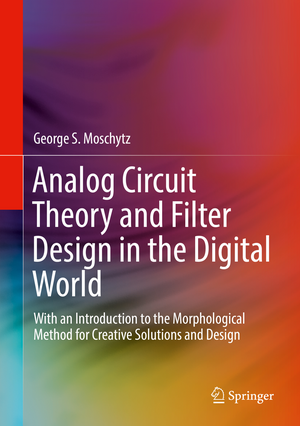Analog Circuit Theory and Filter Design in the Digital World: With an Introduction to the Morphological Method for Creative Solutions and Design
Autor George S. Moschytzen Limba Engleză Hardback – 7 mai 2019
Preț: 753.51 lei
Preț vechi: 918.92 lei
-18% Nou
Puncte Express: 1130
Preț estimativ în valută:
144.20€ • 156.58$ • 121.13£
144.20€ • 156.58$ • 121.13£
Carte tipărită la comandă
Livrare economică 22 aprilie-06 mai
Preluare comenzi: 021 569.72.76
Specificații
ISBN-13: 9783030000950
ISBN-10: 3030000958
Pagini: 595
Ilustrații: XII, 550 p. 934 illus., 921 illus. in color.
Dimensiuni: 178 x 254 mm
Greutate: 1.19 kg
Ediția:1st ed. 2019
Editura: Springer International Publishing
Colecția Springer
Locul publicării:Cham, Switzerland
ISBN-10: 3030000958
Pagini: 595
Ilustrații: XII, 550 p. 934 illus., 921 illus. in color.
Dimensiuni: 178 x 254 mm
Greutate: 1.19 kg
Ediția:1st ed. 2019
Editura: Springer International Publishing
Colecția Springer
Locul publicării:Cham, Switzerland
Cuprins
Mixed-Mode Signal Processing.- Some Key Points from Network Theory.- Filter Specifications and Approximation Theory (The Mathematical Approach to the Approximation Problem).- Filter Tables and Computer Programs (The Physical Approach to the Approximation Problem).- An Introduction to Signal-Flow Graph Theory.- Controlled Sources, Nullors, Active Gain Devices, Impedance Converters and Inverters (Gyrators, NICs, FDNRs, Current Conveyors).- Passive LCR and Active-RC Filters.- A Classification of Single-Amplifier Biquads.- A Morphological Approach to the Design of Active Network Elements.- Active Filter Design Techniques.- Some Elements of Sensitivity Theory.- Random Signals and Noise.- Deriving Current-Based from Voltage-Based Circuits.- From Continuous Time to Discrete Time.- Sampling Theorem and Aliasing.- The Laplace Transform of Sampled Signals: The z-Transform.- Analysis of Switched-Capacitor Filters.- The Four-Port Analysis of Switched-Capacitor Circuits.- Design of Switched-Capacitor Filters.- The Transmission Matrix of SC Circuits and its Signal-Flow Graph.
Notă biografică
George Moschytz is founder and head of the Faculty of Engineering (Bio, Computer, and Electrical Engineering) at Bar-Ilan University, Israel (founded in 2001).
Previously, he was professor and director (1973-2001) of the Institute for Signal and Information Processing at the Swiss Federal Institute of Technology (ETH) in Zurich, Switzerland.
Before joining the ETH EE-Department (where he also received his undergraduate and PhD degrees) he was at RCA Research Laboratories in Zurich (1960-1962) and then, for close to ten years, at Bell Telephone Labs in New Jersey, USA. At Bell Labs he supervised a group designing analog and digital integrated circuits and filters for data communications.
Since 1989, he has been consulting for communications companies in the USA regularly during the summer. He has written and co-authored several (10) books on analog, digital, switched-capacitor, and adaptive circuit and filter design, and close to 400 papers in the field of networktheory and design, signal processing, and circuit sensitivity. He holds several patents in these areas.
He is an IEEE Life-Fellow, was awarded the IEEE-CAS-Education Award, and the IEEE-CAS Mac VanValkenburg Award (the highest IEEE-CAS award), as well as several other IEEE awards (among them the Golden Jubilee Award, and the Third Millennium Medal), and was president of the IEEE Circuits and Systems Society in 1999.
While at the ETH, he served on he ETH Research Council, then on the Swiss National Research Council in Berne, and thereafter, was one of two representatives of Switzerland, on the European Research Council in Brussels.
Before joining the ETH EE-Department (where he also received his undergraduate and PhD degrees) he was at RCA Research Laboratories in Zurich (1960-1962) and then, for close to ten years, at Bell Telephone Labs in New Jersey, USA. At Bell Labs he supervised a group designing analog and digital integrated circuits and filters for data communications.
Since 1989, he has been consulting for communications companies in the USA regularly during the summer. He has written and co-authored several (10) books on analog, digital, switched-capacitor, and adaptive circuit and filter design, and close to 400 papers in the field of networktheory and design, signal processing, and circuit sensitivity. He holds several patents in these areas.
He is an IEEE Life-Fellow, was awarded the IEEE-CAS-Education Award, and the IEEE-CAS Mac VanValkenburg Award (the highest IEEE-CAS award), as well as several other IEEE awards (among them the Golden Jubilee Award, and the Third Millennium Medal), and was president of the IEEE Circuits and Systems Society in 1999.
While at the ETH, he served on he ETH Research Council, then on the Swiss National Research Council in Berne, and thereafter, was one of two representatives of Switzerland, on the European Research Council in Brussels.
Textul de pe ultima copertă
This textbook is designed for graduate-level courses, and for self-study, in analog and sampled-data, including switched-capacitor, circuit theory and design for ongoing, or active electrical engineers, needing to become proficient in analog circuit design on a system, rather than on a device, level. After decades of experience in industry and teaching this material in academic settings, the author has extracted many of the most important and useful features of analog circuit theory and design and presented them in a manner that is easy to digest and utilize. The methodology and analysis techniques presented can be applied to areas well beyond those specifically addressed in this book. This book is meant to enable readers to gain a 'general knowledge' of one aspect of analog engineering (e.g., that of network theory, filter design, system theory and sampled-data signal processing). The presentation is self-contained and should be accessible to anyone with a first degree in electrical engineering.
- Presents material in the form of slides, with accompanying text;
- Demonstrates how the design of many circuit devices, e.g. gyrators, impedance converters, etc. can be accomplished easily, using the ‘Morphological Method’;
- Includes numerous examples from different fields, e.g. circuit devices, active-RC and switched-capacitor circuits and filters, etc.;
- Emphasizes creative design methods and techniques.
Caracteristici
Presents material in the form of slides, with accompanying text Demonstrates how the design of many circuit devices, e.g. gyrators, impedance converters, etc. can be accomplished easily, using the ‘Morphological Method’ Includes numerous examples from different fields, e.g. circuit devices, active-RC and switched-capacitor circuits and filters, etc Emphasizes creative design methods and techniques
